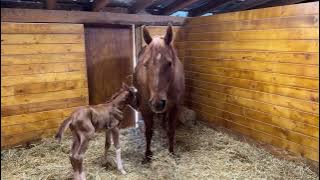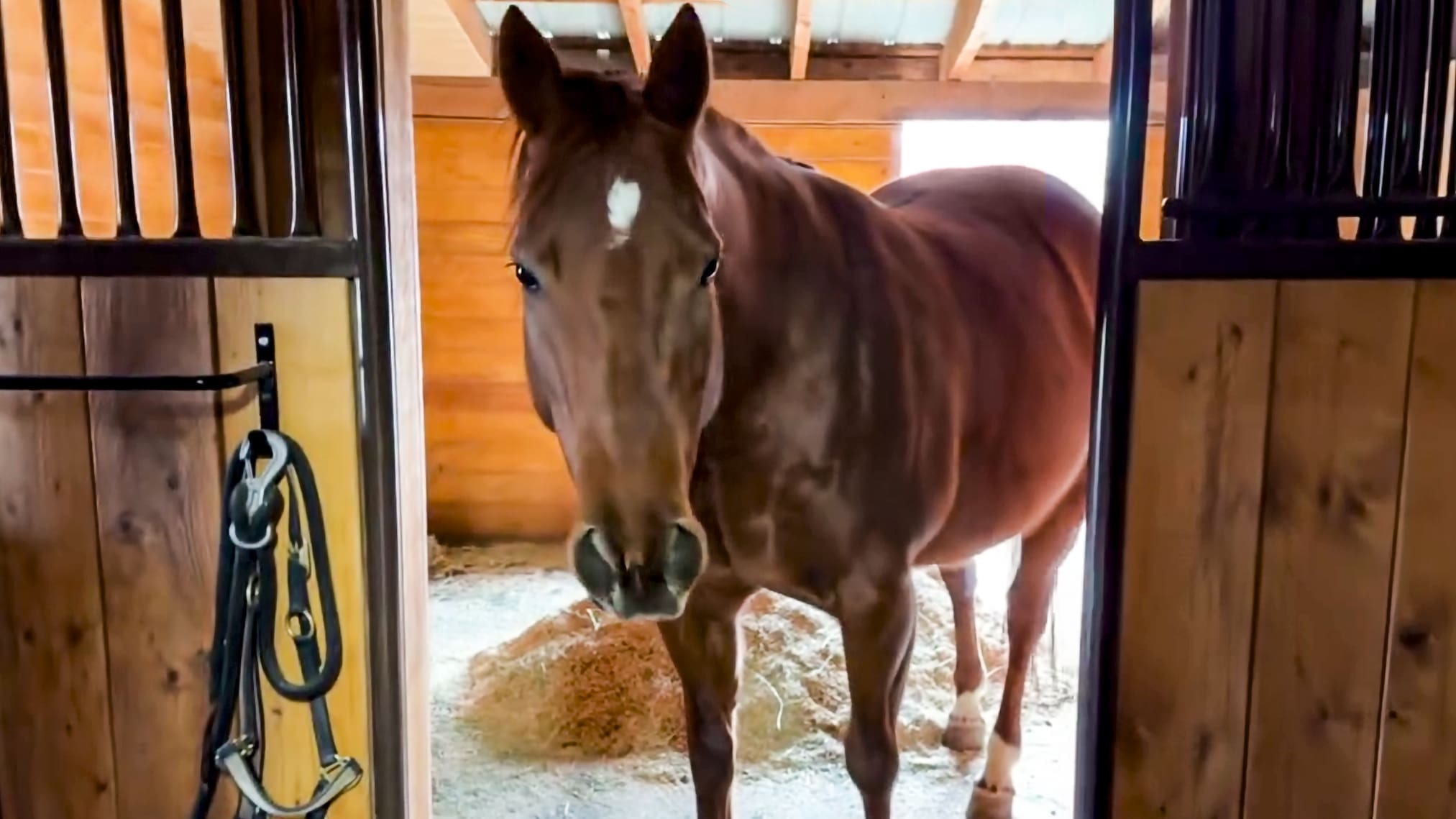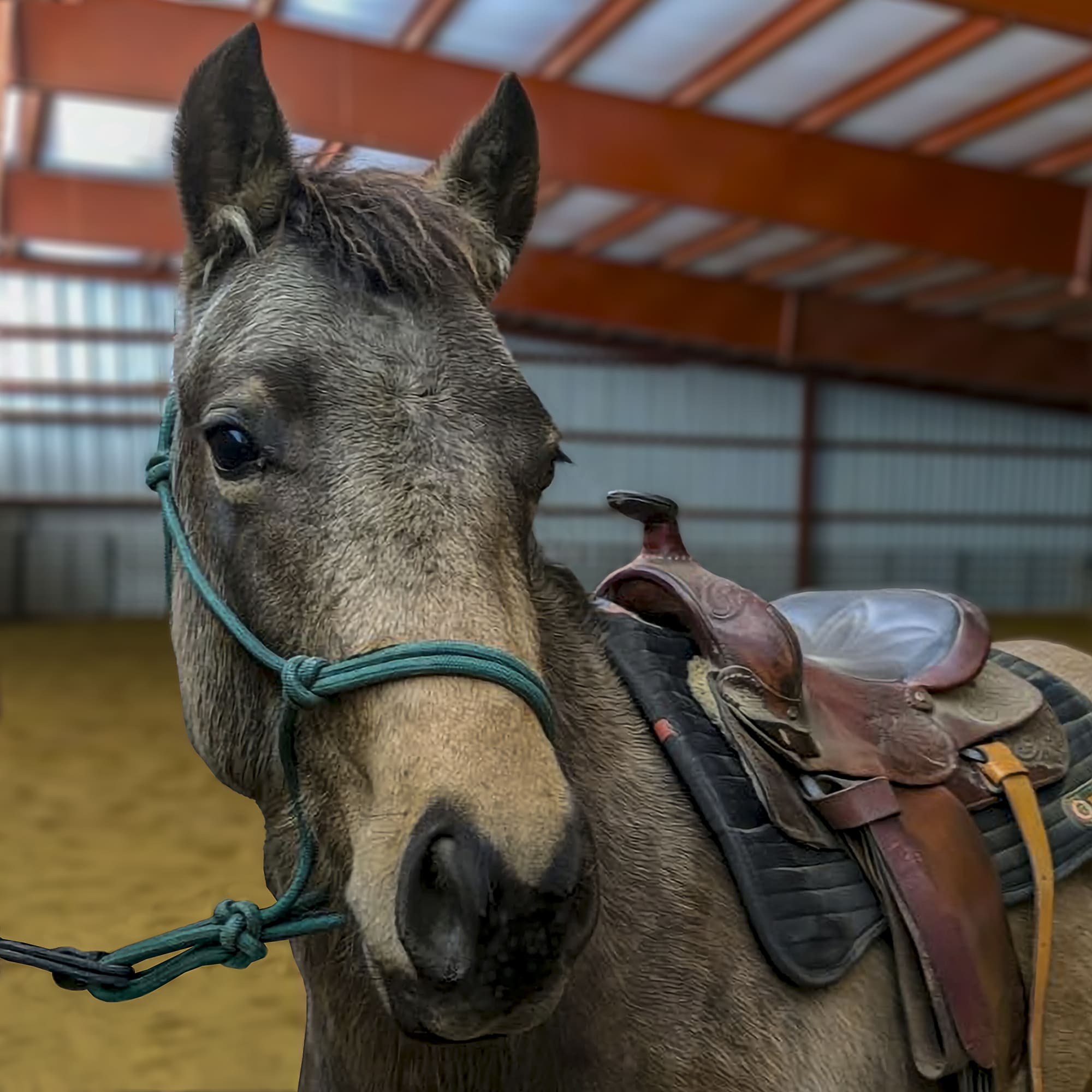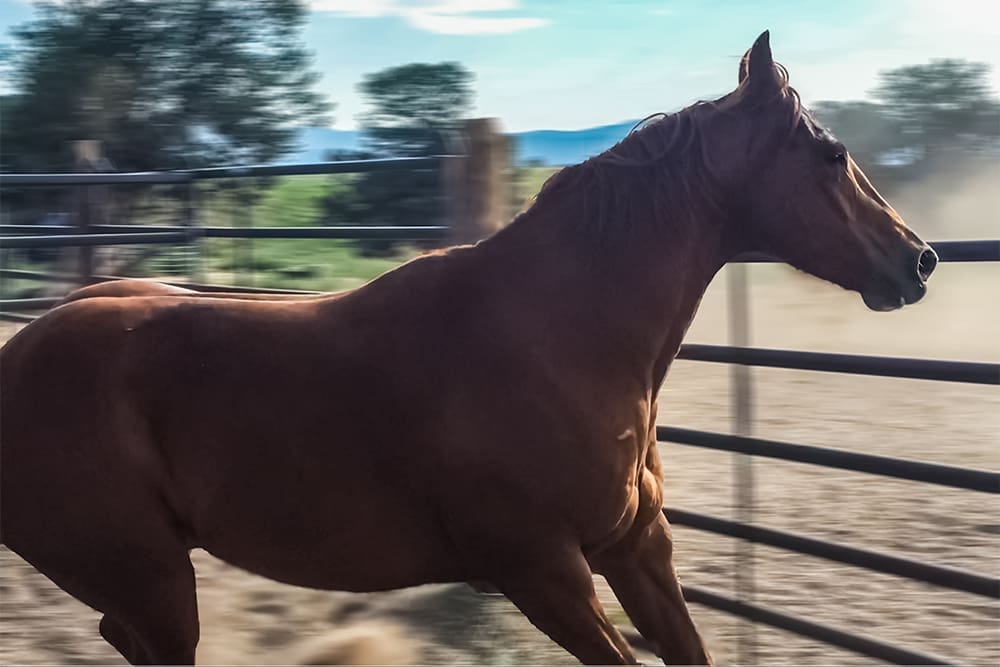
At my ranch, we have seven geldings and one mare. When we brought my new foster mare, Truth, in for training the two mares were instantly drawn to each other like magnets. At first, it was sweet how much they loved each other. Then it became obvious that the otherwise sweet and compliant mares would resemble fire-breathing dragons if we ever tried to separate them.
Both mares became so attached at the hip that even a momentary separation of 10 feet would send both mares into a complete tizzy. Ultimately, we had to separate the mares, and only allowed them to interact when we got them out for training—while working, they were required to follow protocol and behave as they were trained to act. We were able to nip the undesirable behavior in the bud, and the mares went back to their cooperative old selves.
Though highly inconvenient to humans, gregarious behavior (or an unyielding desire to be with others in the herd) is one of the strongest instinctive drives of equines. Often thought of as an affliction by horse owners, a herd-bound horse may display anxious, panicky and undesirable behaviors when it is either taken away from the herd by itself, or are left behind after other horses are removed.
This is a natural, instinctively driven behavior of horses, and it’s an omni-present condition—although most horses are trained to overcome it. There are no quick-fixes to herd-bound behavior, but horses can certainly be taught to accept separation from the herd, and stay calm and obedient despite it. A recent question from one of my podcast listeners, Barbara, reminded me of how imposing this instinctive behavior can be.
Can a horse be desensitized to separation anxiety? My alpha mare is boarded with a pasture mate. We’ve been there for about 2 years. My mare will happily go out alone, but if her BFF even goes around the corner, she goes crazy—running the pasture fence line, screaming and working herself into a lather.
The other horse (also a mare) does not go out alone often, actually rarely, but it is stressful to watch [my mare]. Luckily, she has not hurt herself—yet. We have just started trying to have the other horse lead away for a short time, then come back to see if my mare will calm down when she leaves. Can this—or will this—work? Or are we just causing her more stress?
It’s an excellent question Barbara, and it made me realize that there is an important ingredient for retraining the herd-bound horse, beyond simply separating the horses, that is usually omitted from the recipe for success. But before we talk about the secret sauce, it’s important to fully understand the depth of your horse’s behavior first.
What’s the Big Deal?
For a prey animal, separation from the herd feels like a death sentence. Horses only live in a herd setting, never solitary, because they are reliant on the herd for detecting and fending off predators. You cannot eliminate this instinct, but you can train the horse to override its instinctive urges.
Separation anxiety can rear its ugly head in two common scenarios—one occurs when you take a horse away from the safety and comfort of its herd and it becomes uncooperative (often referred to as barn sour). The other form of separation anxiety happens when a horse’s companion is taken away and it’s left alone, herd-less, to fend for itself.
What many horse owners like Barbara have come to realize is that the latter scenario—the horse that is left behind—is often the hardest to deal with. In other words, the horse you take out of the pen to ride is not as big a problem as the one you leave in the pen. This typically takes the form of running, pacing the fence line, and calling out with increasing panic that escalates unless intervention occurs.
Less dramatic, but just as frustrating, is herd-bound behavior in the horse you take out to ride, if it refuses to cooperate. This often involves impatience, fidgeting, pawing, head shaking, stomping, calling out, ignoring the handler/rider, ignoring trained cues, and downright refusing to do what is asked or to leave the proximity of the herd. It may escalate to blatant disobedience, tantrums, and threats of bucking or rearing from the horse.
Temperament, training, and routine handling all affect herd-bound behavior. There’s not much we can do to change a horse’s temperament but training, regular handling, and teaching a horse how to act appropriately will make an impact on the horse. All horses are instinctively prone to these behaviors, yet for many horses this never becomes an issue.
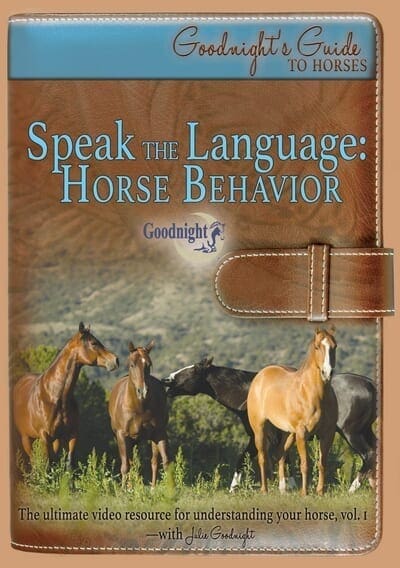
Learn the unique characteristics of a horse’s natural behavior so you are safer, more effective and can better relate to the needs of your horse.
It’s important to remember that herd-bound behavior is normal for horses. It is only through training and experience that horses gain a comfort level with being alone and/or accept a human as a suitable substitute for the herd. Younger horses may be more independent and more willing to leave the herd, while middle-aged and older horses may become increasingly herd bound. I suspect the same pressures that cause differences in the behavior of humans at various stages of their lives, also affects horses. As we age, security becomes increasingly important.
Horses are not only instinctively drawn to the herd (affected by herd gravity), but they also form bonded relationships within the herd (the double whammy). By nature, horses form deep mutual alliances with one other horse in the herd (at the most two). Horse people call them buddies, behaviorists call them associates, and many other people would probably call it friendship.
It can certainly be the case that a horse is not only unwilling to leave the herd, but it also deeply fears any momentary physical separation from its buddy. So, if you remove the associate, even if the other horse remains in a herd setting it may still be emotionally overwrought with separation anxiety. In the case of herds of two horses, when the buddy is removed and there are no other herd mates there, the horse experiences the worst anxiety.
Horses are creatures that thrive on routine and sameness, for the security and predictability it brings them. They are fast learning, detect patterns quickly, and learn routines easily. When a horse is regularly separated from the herd, handled by people, tied up and groomed, and ridden or trained daily, herd bound problems go away because this is part of the horse’s normal routine, and it has reached a comfort level with it.
On the other hand, if the horse is left in the pen with the other horses, day in and day out, with only occasional removal and handling for vet or farrier, the herd becomes its whole world and separation is unthinkable.
Will Gradual Desensitization Work?
It can, but only if you have the secret ingredient. Removing or separating the horses is necessary to reprogram the horse, but it’s only half of the equation. Whether you are dealing with a barn sour horse that throws a fit when you ask it to leave the barnyard, or the left-behind horse that runs a rut in the ground when you take its buddy away, the secret is in what you do after the separation.
It’s not the length of the separation that matters, whether it’s short or long, it’s bringing the horse back to a calm and compliant state of mind before returning it to the herd (or reuniting it with its cohort) that has the greatest impact. In other words, if you remove the buddy horse for a short time but return it while the left-behind horse is emotionally overwrought, you have further reinforced the undesirable behavior. The left-behind horse believes its emotional outbursts caused the buddy horse to return, so it is certain to act the way next time.
Whatever the horse is doing at the moment you release the pressure, is what you just trained the horse to do. This is a universal truth that applies to all matters of training horses—timing is everything. If the horse only gets relief once it has settled, taken a deep breath, and returned to its normal compliant state, then that is the behavior you have reinforced. Bringing the horse back to a calm and thinking state of mind once it is separated and before returning it to the herd, must occur in order to reprogram the horse’s behavior.
Unbinding the Herd-Bound Horse
Now that you know that the secret sauce for curing herd-bound behavior is in managing and redirecting the horse’s emotions before reuniting them, I’ll share my formula for teaching a horse to deal with its separation anxiety. I’m assuming you are starting with a trained horse that acts appropriately when it is not having separation anxiety—that you have control and cooperation from the horse otherwise, and that these problems only occur when the horse is isolated from other horses. If your horse is always out of control, this plan won’t work—that horse needs more basic training.
Step One: Create a New Routine
On a daily basis, you’ll need to separate the horse from the herd and do the same routine with it—maybe some groundwork, followed by grooming, followed by some time spent tied up. The first day will be the hardest, with the most emotionality, but with each passing day, the horse learns what comes next and comes to accept the routine. Consistency is key. When it happens every day, the same way, at least 5-6 days a week (no one ever said horse training was easy), the horse trains to a new routine quickly.
Step Two: Manage Emotionality
The key to success is in reminding the horse how good it feels to be relaxed. Anxiety, anger and frustration are the primary emotions of the horse you’ll be managing. Your own emotions must be relentlessly calm and steady. Treating the horse’s emotionality as a mental health issue and not a training issue, will help the horse the most. My first goal is always to reduce the horse’s anxiety by asking it to lower its head to the ground and cue it to take a deep breath by taking one myself.
To cue the horse to relax, I exaggerate my body language and breathing to exude calmness (shoulders rounded, energy low, averted eyes, deep sighs). I’ll stroke and soothe the horse as it relaxes, to show the horse that being relaxed feels better than being anxious. It is not hard to get an anxious horse addicted to calmness, but you must show them how to do it—lower the head and take a deep breath. After a few days of this, the horse will start lowering its own head when it feels anxious, in an attempt to self-medicate.
For many horses, especially the hotter, flightier horses, movement may be soothing but it may also wind a horse up, as in the case of the left-behind horse frantically running up and down the fence. Sometimes allowing a horse to move its feet helps it calm down—walking quietly, turning right, then left, then right. But moving it around with quick, abrupt, or harsh transitions and changes of direction is not calming.
When I have a problem with a left-behind horse that is panicked when left in the pen, instead of allowing the horse to pace frantically, winding itself up and potentially hurting itself, I will simply tie it up in a safe and comfortable place. When you take away its ability to frantically pace, and when the horse is trained to stand tied, it will usually settle down once you do. My horses prefer to be caught and tied up when we take the other horses out, even if we are not riding them—it makes them feel part of the action and it’s way better than being the only one left behind.
Step Three: Engage the Mind and Regain Focus
Once you’ve addressed the out-of-control emotions of the horse, it’s time to engage its mind, get it thinking, and remind the horse of what it knows. Sometimes it seems like the herd-bound horse has completely forgotten all its training, but horses never forget. Put the horse to work, giving it cues and expecting a response, as soon as its mind settles.
When engaging the horse’s mind, I’ll revert back to the simplest commands that I’m sure the horse knows. Go, stop, turn right, turn left, slow down, speed up. All I want is for the horse to listen, think, and respond like it is trained to do. This almost always has a calming effect on the horse as its mind becomes engaged and it reverts to the comfort of what it knows.
This is not the time to ask for the hard stuff or train something new. It is the time to remind the horse that it knows how to act and respond. Most importantly, I want to use this time to re-establish my connection with the horse. I want the horse to give me even the most basic response so that I can praise it copiously and remind it how good it feels to get back to normal.
Engaging the horse’s mind by giving it known cues, waiting for the appropriate response, then releasing and praising the horse, will always help when a horse is feeling anxious. Do this with the horse that is left behind too—leaving it to its own devices will not work.
Step Four: Reimpose Known Rules of Behavior
Presumably, your horse has established manners and rules of behavior that you normally expect from the horse. During times of emotional duress, the horse may temporarily become unresponsive or disregard these rules. Your job, as the leader, is to redirect the horse’s behavior (not punish) and remind it of your expectations.
Engaging the horse’s mind by asking it to comply with simple commands will help you reimpose the rules of behavior (manners). But this is where the onus comes to you. If you have established good manners in your horse, aside from the separation issue, you can retrieve the horse quickly. If you have not established good leadership with the horse in the best of times, how can you expect it in the worst of times?
Normally, I expect my horses to stand still whenever I ask. I require them to stand tied for some time every day, I teach them to ground tie and practice it regularly, and I always reinforce standing still once I have asked it of the horse. So, when the horse temporarily loses it and is frantically dancing around, I have known skills and known expectations to fall back on, as I ask the horse to comply and remind it of what it knows. If you have not done this foundational work up front, you have nothing to fall back on when the horse becomes overwrought. That’s your bad.
Time Well Spent
While herd-bound behavior is a constant presence with horses, with proper training and handling, it is completely manageable. All horses are prone to becoming herd-bound, yet most riding horses have learned to cope. It’s not an affliction of the horse—it’s normal behavior.
When herd-bound behavior becomes a problem, it generally stems from a lack of training and handling, or inadequate training and handling. As I mentioned, no one ever said horse training was easy or a part-time job, but these are totally solvable problems—if you make the investment of time and energy your horse requires. If I had a quick fix to offer, I’d be the wealthiest horse trainer of all time.
Fixing the herd-bound horse is not possible to do in one day, and it requires your full commitment and relentless consistency. Before your horse lets go of its anxiety about being separated from other horses, it must get comfortable and relaxed spending time with you, accept your leadership, and feel safe with you. Ultimately, you are the secret ingredient, and the responsible party.

Learn the unique characteristics of a horse’s natural behavior so you are safer, more effective and can better relate to the needs of your horse.
